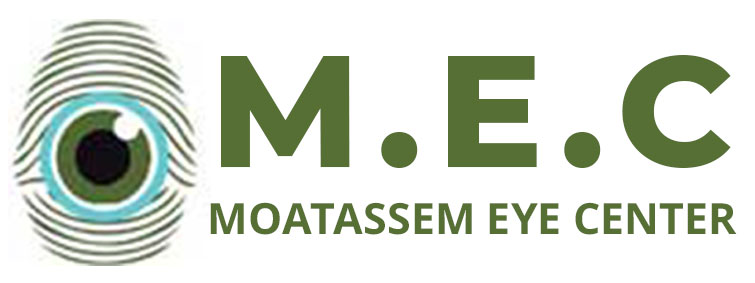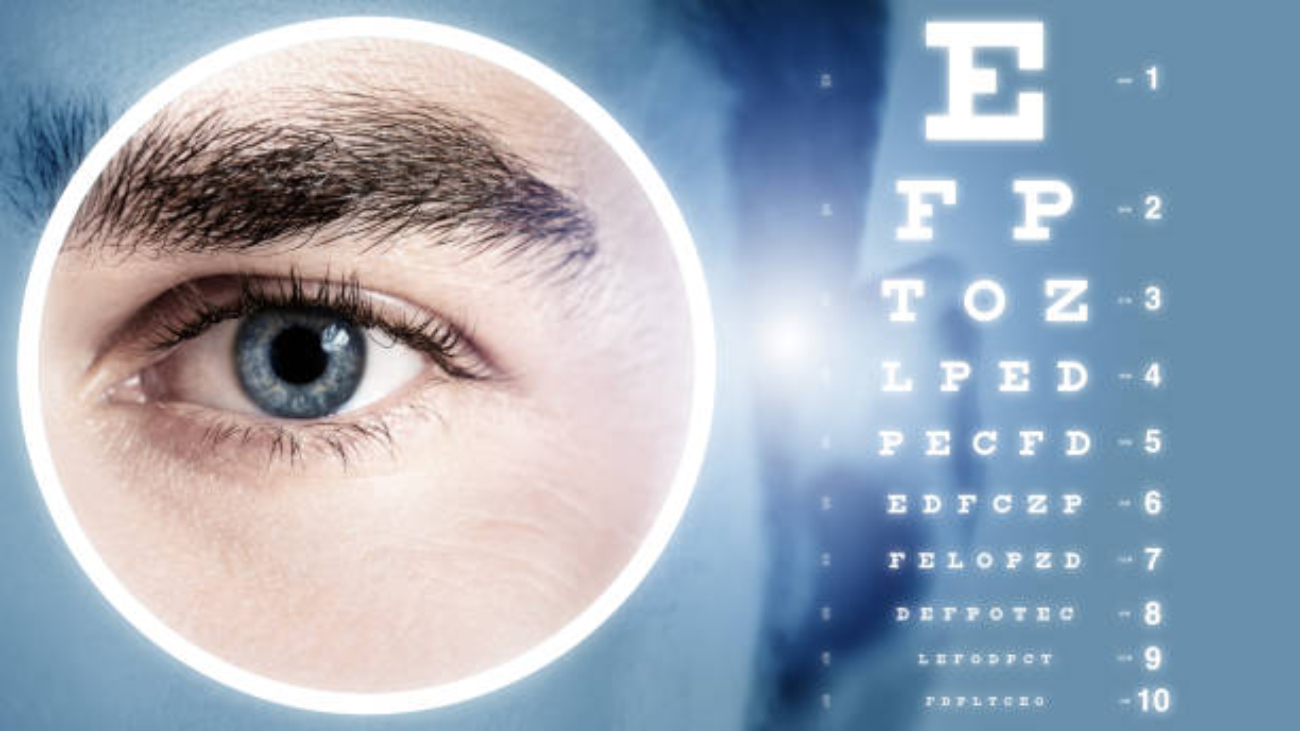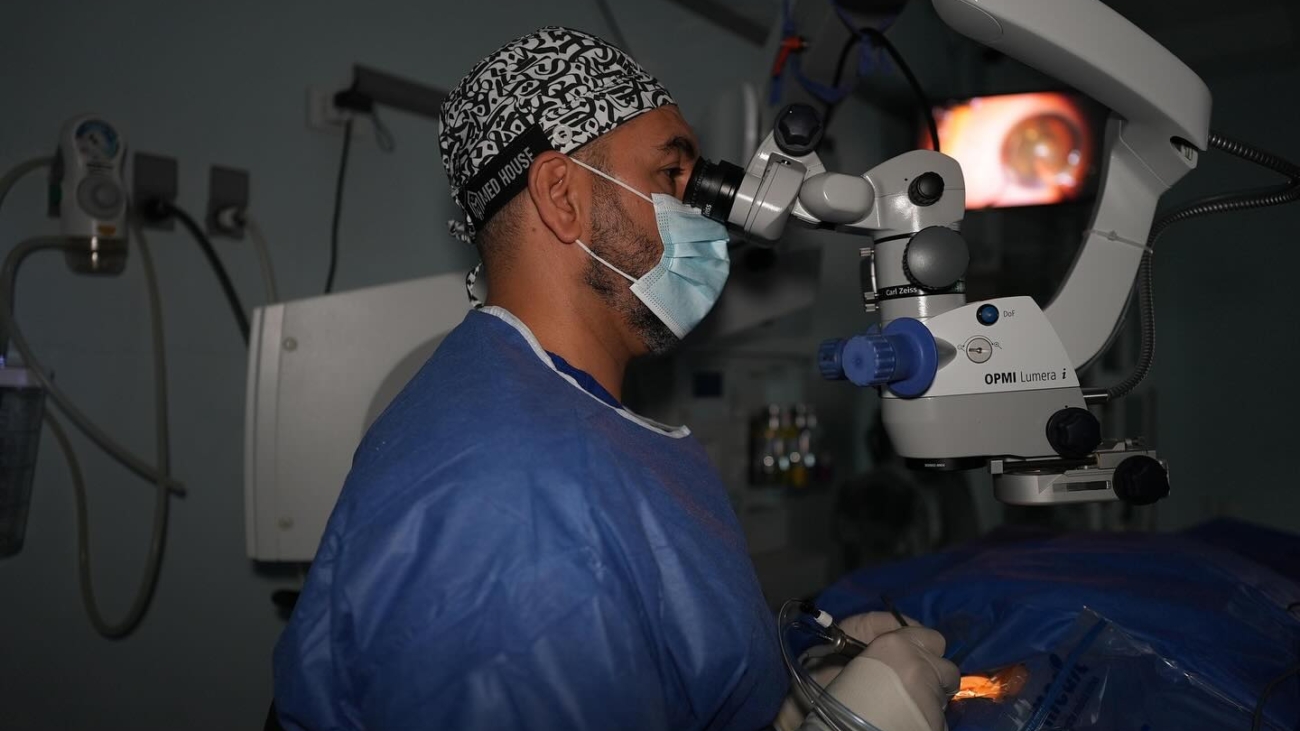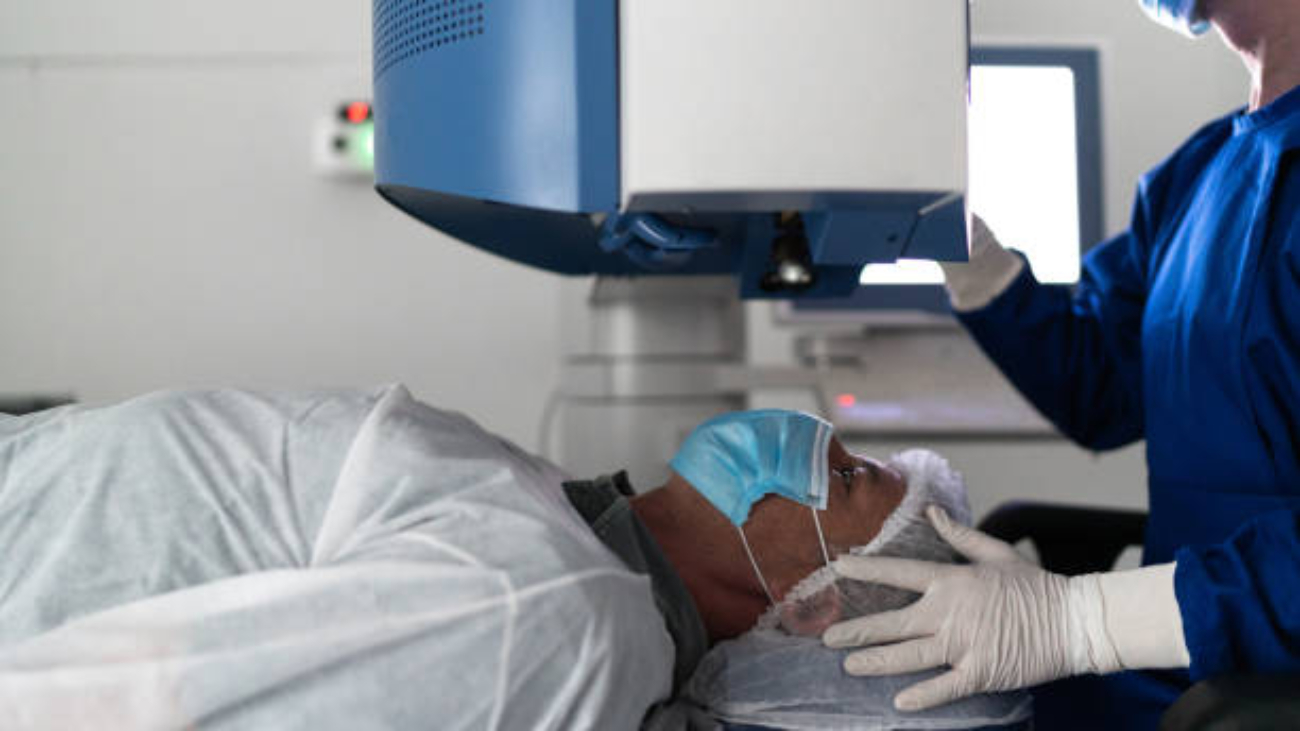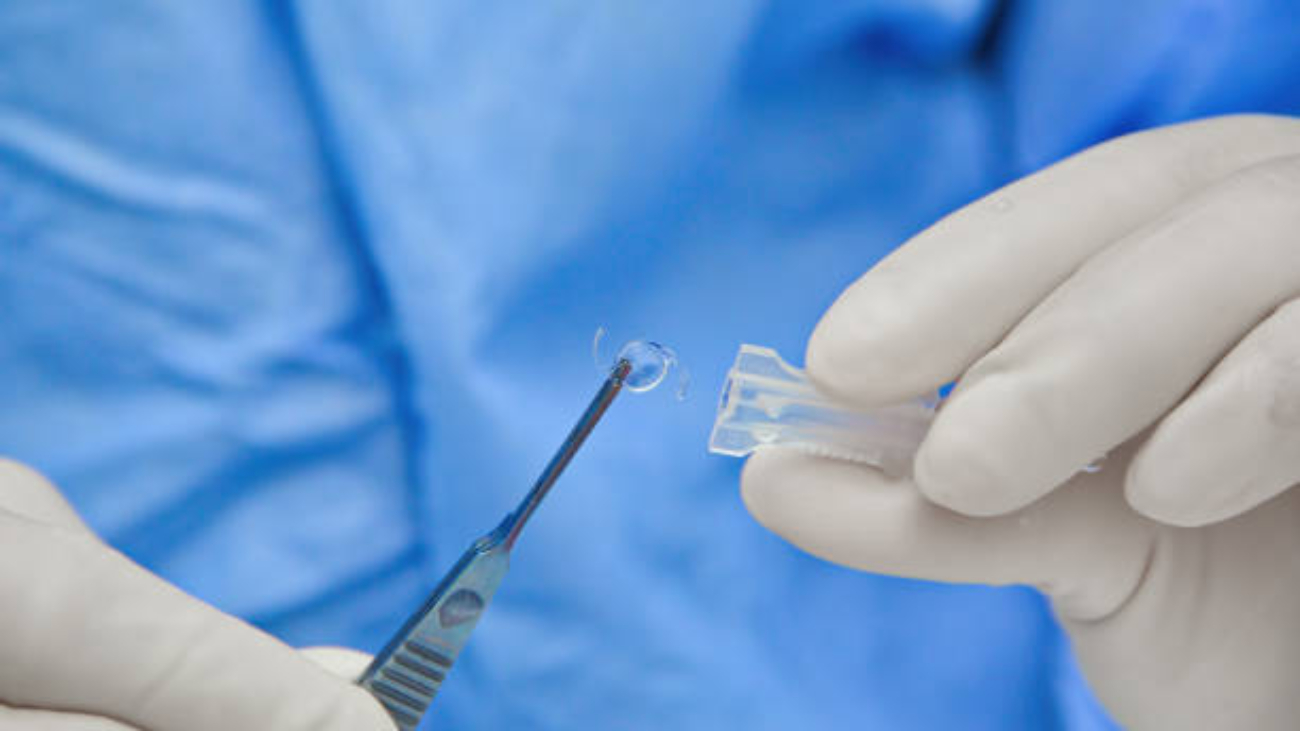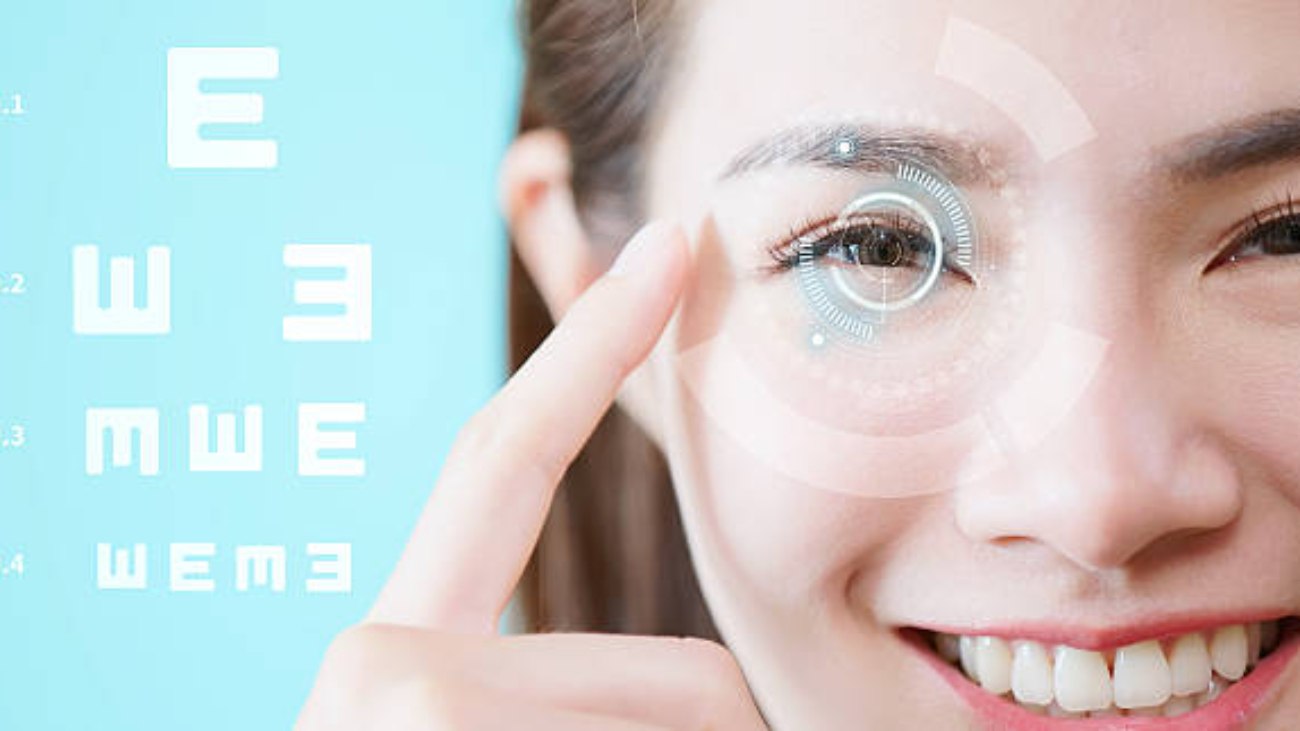Eye care technologies are evolving daily, and one of the latest therapeutic procedures introduced is the Femto-Smile technique. This advanced technique is considered a miraculous and radical solution for correcting vision problems without the need for prescription glasses or contact lenses, all while being completely safe and avoiding the high risks associated with traditional surgical procedures. What is this operation, what are its advantages and disadvantages, and what are the key details related to it? We will address these questions from the European Al- Moatassem Center, under the supervision of the esteemed Dr. Ahmed El Moatassem, a specialist in ophthalmology and its surgery.
What is the Femto-Smile technique?
The Femto-Smile technique is a modern therapeutic method in the field of ophthalmology that addresses refractive vision defects with high precision using a specialized type of laser known as femtosecond laser. This laser corrects the shape of the cornea and reshapes its upper surface without negatively impacting it.
The femtosecond laser works by precisely separating the layers of the cornea and extracting a small lens-shaped portion to correct the curvature of the cornea. This portion is removed through an extremely precise surgical incision, without pain or significant risk.
Femto-Smile is considered the latest generation of approved surgical procedures for correcting refractive vision problems and is significantly less invasive compared to other methods. It can treat myopia, hyperopia, and astigmatism.
What are the Advantages and Disadvantages of the Femto-Smile technique?
Any therapeutic procedure, regardless of its safety and effectiveness, may be viewed differently by patients—some highlight its numerous advantages, while others focus solely on its associated drawbacks. Although the negative aspects of the Femto-Smile procedure are transparently and credibly low, there are several positive and negative points that we will highlight to ensure you are fully informed about all the details of this procedure.
Advantages of Femto-Smile
The Femto-Smile technique offers many advantages that make it a preferred option in eye clinics.
favored by both doctors and patients alike, due to the numerous positive and remarkable experiences associated with it.
Some of the key benefits include:
- The procedure is very quick, lasting only a few minutes to fully correct vision quality.
- It is extremely safe and yields excellent results in vision correction and quality enhancement.
- Post-operative symptoms and side effects are very limited, and even potential temporary dry eye is unlikely in the immediate aftermath.
- The treatment is performed at a depth of 110 to 130 microns from the corneal surface, achieved by separating the internal layers of the cornea.
- The surgical incision is very precise, not exceeding 2-4 millimeters, which does not affect the lens or cornea and heals automatically.
Disadvantages of Femto-Smile
As we have seen, the Femto-Smile technique is one of the safest and most effective treatments available; however, there may be certain exceptions and drawbacks that cannot be overlooked. These include:
- Inability to correct some refractive vision defects at times, which may necessitate further treatment.
- Reduced effectiveness for severe cases of hyperopia, as the capabilities of Femto-LASIK are primarily focused on correcting myopia.
Eligible Patients for the Femto-Smile technique
Not every patient is eligible for the Femto-Smile procedure. Dr. Ahmed El Moatassem recommends a specific group of patients who are suited for this operation, ensuring it aligns perfectly with their condition and guarantees optimal results in addressing vision problems. This group includes:
- The eye and cornea must be free from all diseases and injuries.
- The patient must be at least 18 years old or older.
- Mild astigmatism is acceptable, if present.
- Moderate myopia ranging from -1 to -8 diopters, no more.
- Stability of visual acuity for at least one full year prior.
- Astigmatism should not exceed 3 diopters.
Conversely, there are cases that are exempt from the Femto-Smile procedure.
as this operation is not suitable for them and cannot be performed, including:
- Pregnant and breastfeeding women.
- Recent need for multiple changes in prescription glasses or therapeutic contact lenses.
- Conditions of elevated intraocular pressure or glaucoma.
- Corneal scarring or ulceration.
- Keratoconus.
- Patients with chronic diseases, such as uncontrolled diabetes.
- Presence of cataracts significantly affecting vision quality.
Diagnostic Stages Before Performing Femto-Smile
Dr. Ahmed El Moatassem typically takes the patient’s medical history to understand their general health status, vision problems, and any symptoms observed. He conducts a series of diagnostic tests, which include:
- Examination of the cornea to obtain accurate readings and meticulous measurements, as the Femto-Smile procedure relies entirely on precise measurements, topographic imaging, corneal thickness, and absence of any problems or disorders.
- Assessment of eye moisture to ensure that dryness is not present, as dry eye prior to the Femto-Smile procedure is a reason to exclude the operation since it may significantly increase the risk of post-operative dry eye.
- Measurement of pupil size, since a wide pupil can predispose the eye to notable pain after the procedure and vision problems in bright lighting conditions, as well as night vision issues.
- Examination of the fundus to evaluate the health status of the optic nerve and rule out any diseases or health concerns, along with measuring intraocular pressure to exclude glaucoma or “blue water,” which is also excluded from this procedure.
Steps of the Femto-Smile technique
The Femto-Smile technique is performed by following a limited set of specialized steps that are relatively straightforward and conclude within a few minutes.
after which the patient notices an immediate improvement in their vision quality. These steps include:
- First, the patient is prepared for entering the operating room by wearing special attire and sanitizing their hands and face.
- The patient then enters the operating room and lies down on the designated operating table.
- Local anesthetic eye drops are applied to the surface of the eye to numb the area, ensuring the patient feels no pain.
- A specialized device, resembling a clamp, is then used to keep the eye open for ease of procedure.
- Dr. Ahmed El Moatassem uses a laser device to create a precise surgical incision on the surface of the cornea.
- He then accesses the corneal layers and resects a portion of the tissue to correct the shape of the cornea and address vision defects.
- The procedure concludes with the application of a patch on the eye or the placement of surgical sutures at the incision site if necessary.
Post-Femto-Smile Symptoms
It is important to clarify that post-operative symptoms of the Femto-Smile technique are completely normal and pose no risk; these are typical side effects that represent part of the healing process. On the other hand, we will mention later the complications that carry high risks and may result in complete failure of the Femto-Smile procedure, which include:
- Eye redness.
- A sensation of itching in the eye.
- Seeing halos around light sources, especially in the evening.
- Temporary blurry vision.
Failure of the Femto-Smile technique
After identifying the post-operative symptoms of the Femto-Smile procedure, it is essential to recognize the signs of failure of this procedure, or in other words, the potential complications that may arise.
These complications can result from an error in selecting the procedure.
the patient’s unsuitability for the procedure, issues in determining corneal measurements, severe dryness of the cornea.
or delayed healing of the cornea after the operation. The most significant of these complications include:
- Corneal inflammation.
- Complete lack of vision following the procedure.
- The occurrence of bacterial or viral infections.
- Damage to the cornea due to the removal of tissue.
Cost of the Femto-Smile technique
It is well known that the costs of medical procedures of all kinds are of great significance to patients. Therefore, we offer at Al- Moatassem European Center treatment procedures of the highest therapeutic quality at the best prices in the United Arab Emirates.
As for the costs of the Femto-Smile technique, they are not defined by a fixed amount but are instead linked to the patient’s condition and many ancillary factors, including:
- The location of the medical center and the completeness of its services and modern facilities.
- The expertise of the surgeon and the positive experiences of their patients in treating vision defects.
- The therapeutic techniques used during the procedure and their advancement.
- The inclusion of diagnostic and follow-up costs before and after the procedure.
In general, it can be stated that the Femto-Smile procedure is quite reasonably priced, estimated to average between $500 and $700, making it accessible to most patients. Of course, this cost is approximate and may vary based on many factors.
My Experience with Femto-Smile
We did not rely solely on one experience from a patient who previously underwent the Femto-Smile procedure at Al- Moatassem European Center for Ophthalmology and Surgery in Dubai. Instead, we gathered the general experiences of hundreds of patients who have undergone this procedure at different times and with varying conditions to provide you with as much feedback and evaluations related to this procedure as possible, including:
- After many years of relying on bothersome prescription glasses, I underwent the Femto-Smile procedure, and just one week later, I achieved stunningly perfect vision.
- I suffered from nearsightedness since childhood and was unable to read or see normally. However, just a few hours after the procedure, I could see both distant and close objects with ease, and my self-confidence increased remarkably.
- I had a procedure that was supposed to correct my vision, but it actually did not help at all. My eyesight worsened, making driving and working difficult. However, with the Femto-Smile LASIK at Al- Moatassem European Center, I achieved results that exceeded my expectations, and the quality of my life improved for the better.
When Does Vision Return to Normal After the Femto-Smile Procedure?
Vision typically returns to normal just a few days after the Femto-Smile procedure.
The improvement continues gradually after the operation.
with patients reaching their desired final results in terms of vision quality and safety within one to two weeks post-procedure.
Which is Better: Femto-LASIK or Femto-Smile?
In reality, statistics have shown that the Femto-Smile procedure has proven its ability to correct vision defects and has significantly outperformed Femto-LASIK. This is due to several distinguishing factors compared to traditional Femto-LASIK, which we will summarize in the following comparison:
| Comparison Aspect | Femto-LASIK | Femto-Smile |
| Flap | Requires the creation of a flap. | Does not require a flap. |
| Types of Laser Used | Excimer laser. | Femtosecond laser. |
| Laser Application | Applied in the layer beneath the created flap. | Applied directly to the surface of the cornea. |
| Size of Surgical Incision | 4-5 mm. | 1-3 mm. |
| Surface Epithelial Tissue Removal | Removed to create the flap. | Preserved. |
| Procedure Duration | 10-15 minutes. | Approximately 5 minutes. |
| Healing Speed | Several weeks. | Up to two weeks. |
Important Instructions After Femto-Smile Pro Surgery
If the patient follows all the guidance and instructions provided by Dr. Ahmed El Moatassem after the procedure, we guarantee an ideal healing period without obstacles, God willing, and achieving optimal vision results within a few short days.
Here are some of the key instructions and guidelines after leaving the operating room:
- Avoid driving immediately after leaving the operating room; seek assistance from a friend or relative for transport home.
- Avoid strenuous activities such as swimming, horseback riding, and weightlifting for several days.
- Ensure adequate rest after the procedure to prevent eye swelling.
- Place several pillows under the head when sleeping and keep the head elevated.
- Avoid washing the face or directing water to the eyes directly to prevent infection.
- Use the prescribed eye drops as directed and apply them according to the instructions.
- Completely avoid cosmetics and skincare products near the eyes.
- Inform the doctor if any severe symptoms occur, such as eye bleeding, severe pain, or unusual blood redness.
When Does Vision Stabilize After Femto-Smile Surgery?
The Femto-Smile procedure yields immediate and direct results. The timing of the appearance of positive outcomes varies relatively among patients, depending on the prior condition and health of their eyes, as well as the experience of the surgeon in selecting and applying the most appropriate procedure with the required quality. However, in most cases, a few hours after the procedure, the patient can see clearly without significant issues. After a few days, the quality of vision continues to improve, reaching the ideal vision that the patient aspires to.
How Long Does the Femto-Smile Procedure Take?
The duration of the Femto-Smile procedure in the operating room is about 7 minutes at most. There may be a slight increase in time for anesthetizing the patient and preparing them for entering and exiting the operating room. It is important to note that this short duration of the procedure does not correlate with the quality of vision outcomes for patients afterward. The speed of the procedure is due to the use of femtosecond laser technology, which can separate layers of the cornea and remove portions of it in just fractions of a second. Additionally, the results of this procedure are comparable to other LASIK surgeries and significantly outperform them.
Best Eye Doctor in the UAE
Refractive vision problems are the most common issues within the UAE and beyond, which is why everyone is seeking the best eye doctor in the UAE to treat these issues with the highest levels of precision and professionalism. Dr. Ahmed El Moatassem, a specialist in ophthalmology and eye surgery, is considered the best in the field of ophthalmology in Dubai and the entire United Arab Emirates.
He has performed over 30,000 LASIK and refractive vision correction procedures, all of which have been a resounding success, yielding outstanding vision results. Dr. Ahmed combines theoretical knowledge and exceptional professional skills with practical experience and a golden surgical hand, having worked in various roles that have enhanced his profile and provided him with additional expertise over the past 20 years.
He has taught the ophthalmology course at Ain Shams University in Egypt and joined the American Academy of Ophthalmology. He is also a member of the Egyptian Ophthalmological Society and the Royal College of Surgeons of Edinburgh. Furthermore, he has participated in hundreds of leading medical conferences and seminars, obtaining certificates of attendance, in addition to conducting dozens of research papers and studies that have been published in prestigious international journals and received commendable evaluations. Therefore, he is regarded as the best eye doctor in the UAE, as well as in Egypt, Iraq, and Saudi Arabia.
